Direct DNA Extraction Kit (Bacteria)
For the extraction of DNA from enriched Gram negative and positive bacteria from food and culture samples
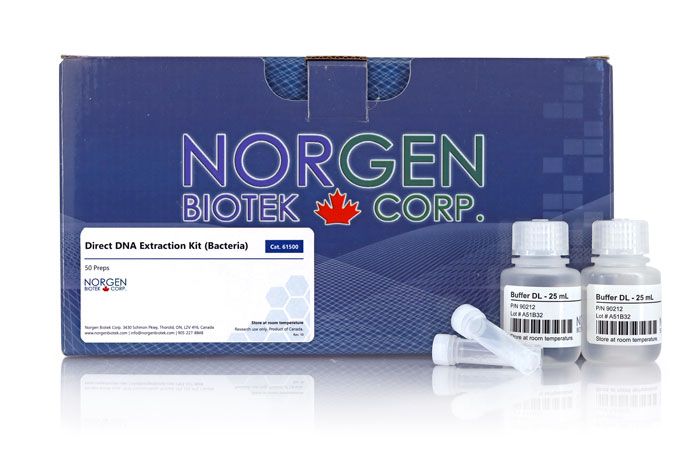
For research use only and NOT intended for in vitro diagnostics.
Direct DNA Extraction Kit (Bacteria)
For the extraction of DNA from enriched Gram negative and positive bacteria from food and culture samples
Register today to receive an exclusive 15% off* on your first order.
Features and Benefits
- Rapid procedure
- Easy and convenient protocol
- Reproducible
- Applicable for high throughput detection platforms
Norgen's Direct DNA Extraction Kit (Bacteria) contains a Direct Pathogen Extraction Buffer (Buffer DL) and pre-filled bead tubes for the extraction of DNA from enriched Gram negative and positive bacteria from food and culture samples. The kit first allows for the extraction of DNA directly from bacteria using mechanical homogenization with Buffer DL. The cell debris is then removed by a short centrifugation and the clean supernatant is ready for use in PCR reactions. Buffer DL is designed to stabilize extracted DNA and inactivate PCR inhibitors to provide a rapid and economic solution for high throughput pathogen detection, particularly for Gram-positive bacteria such as Listeria spp. Norgen's Direct DNA Extraction Kit (Bacteria) is compatible with sensitive detection applications including end-point PCR and real-time PCR.
Direct DNA Extraction Kit (Bacteria)
Procedure
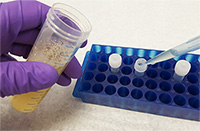
1. Take 1 mL from enriched culture
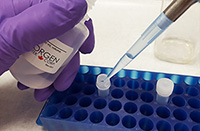
2. Pellet the cells and resuspend with 400 µL of Buffer DL
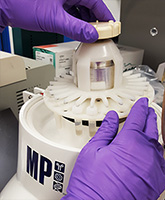
3. Homogenize in a bead beater
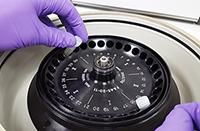
4. Remove the cell debris by centrifugation
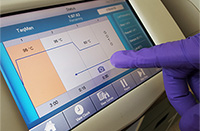
5. The clean supernatant can be used directly in PCR
Details
Supporting Data
Figure 1. Detection of Gram negative (E.coli) and Gram positive (Listeria spp.) bacteria using Norgen's Direct DNA Extraction Kit (Bacteria) in real-time PCR system. Two microlitres of the clean supernatant was directly added to a PCR reaction (total 20 µL) to detect 16s rRNA target or Listeria spp. specific gene for E.coli and Listeria spp. respectively. Targets were successfully amplified, indicating the high quality of the inhibitor-free DNA that was extracted using Norgen's Direct DNA Extraction Kit (Bacteria). This kit is applicable for rapid and sensitive microorganism detection for food quality monitoring and other high throughput analysis applications.
Storage Conditions
All solutions should be kept tightly sealed and stored at room temperature. This kit is stable for 2 years after the date of shipment.
Component | Cat. 61500 (50 preps) |
|---|---|
Buffer DL | 2 x 25 mL |
Bead Tubes | 50 |
Product Insert | 1 |
Documentation
FAQs
Bead Tube
If the DNA does not perform well in downstream applications, it may be due to one or more of the following:
- Too much starting material.
Reduce input volume from 1 mL to 0.5 mL or dilute the sample from step 2e in a ratio of 1:10 in Buffer DL.
- PCR inhibitors from cell culture media or food.
If food-related PCR inhibitors or cell culture media interfere with the PCR, the cell pellet can be washed with 400 µL of Buffer DL as described in step 2a.
- PCR reaction conditions need to be optimized.
Take steps to optimize the PCR conditions being used, including varying the amount of template, changing the source of Taq polymerase, looking into the primer design, and adjusting the annealing conditions.
Citations
| Title | Fundamentals of Forensic Biology |
| Citation | Fundamentals of Forensic Biology 2024. |
| Authors | TR Chandrakar, A Biswas |
| Title | Survey for Carbapenem Resistant Klebsiella Pneumoniae among Patients Attending Aminu Kano Teaching Hospital, Kano, Nigeria |
| Citation | UMYU Journal of Microbiology Research (UJMR) 2024. |
| Authors | Aminu, B.M. |
| Title | Biodegradation of low density polyethylene (LDPE) modified with dye sensitized titania and starch blend using Stenotrophomonas pavanii |
| Citation | International Biodeterioration & Biodegradation 2016. |
| Authors | Ch. Tahir Mehmooda, , , Ishtiaq A. Qazia, Imran Hashmia, Samarth Bhargavab, Sriramulu Deepa |
| Title | Microbial population dynamics and profiling of quorum sensing agents in membrane bioreactor |
| Citation | International Biodeterioration & Biodegradation 2015. |
| Authors | Hira Waheeda, Imran Hashmia, , , , Sher Jamal Khana, Sang Ryoung Kimb, Muhammad Arshada, Habib Nasirc |
